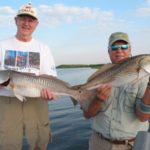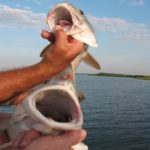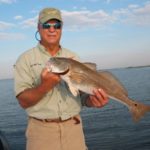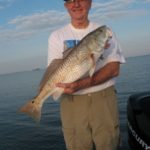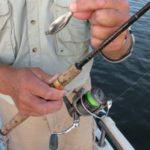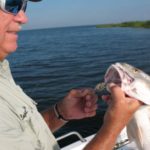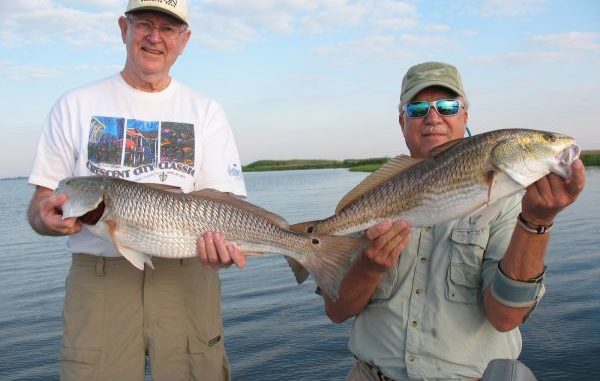
Looking for some great fall action? Place your bet on these Lafitte hotspots, where everyone is a winner.
October changes everything. In gaming parlance, you’d say it reshuffles the deck and ups your odds for a winning hand.
How? Well, for one thing, we finally get a genuine change in the weather. September teases us with some lower temperatures and humidity, but October makes it clear that summer is over, the scorching heat and insufferable humidity have retreated for another year, and fall is here — for real.
Also, daylight comes even later, since daylight savings time doesn’t end until the first week of November. I actually like the fact that I can sleep so much later and still be on the water at daybreak.
And the best change of all? The fish are transitioned into the inside waters, meaning they’re easier to find and they’re within reach of even small boat anglers.
On top of that, hunting season opens for ducks, rabbit, squirrel, quail and deer, and football season is in full swing.
But where to head for some great fall fishing? Well, Lafitte is a perennial hotspot for fall trout and redfish action, so I called Capt. Mike Daigle of Cast-it Charters (985-331-8548) to see if we could make a few casts.
I climbed aboard his 24-foot bay boat at the dock of the Seaway Marina, shook hands with fellow fisherman Garry Leblanc, and Daigle’s big Mercury Optimax powered us toward our destination.
According to Daigle, the potential for catching fish multiplies this month.
Trout were a scarce commodity throughout the summer, and bigger boats and long boat rides were necessary to find any of the elusive fish. Reds, on the other hand, became the staple. Anglers pounded the inside banks with a variety of, baits and most of the persistent ones managed to catch their fair share.
But one thing Daigle said was different this summer was the sheer size of the reds they caught.
“Normally we’ll catch good eating-sized redfish over the summer — fish in the 16- to 18-inch range, and a few stretching to 20 inches or so,” he said. “But this year we consistently caught big reds in the 27-inch-and-over class. Bulls.
“Great action, hard fighting and a blast to fight with light tackle.”
By light tackle Daigle meant pretty much our standard armament: a spinning reel in the 2500 series matched with the appropriate rod. And for line, he likes Berkley Trilene 10-pound monofilament.
Snap on a popping cork about 18 inches above a ¼-ounce jig, slide on your favorite plastic, and you’re locked and loaded.
Baitcasting reel affectionados are typically armed with reels in the 1000- to 2000-series class spooled with braid or mono and mounted on a suitable 6 ½- to 7-foot rod.
This is light tackle for bull redfish, but it is perfectly capable of wrestling and landing the big beasts under most shallow-water conditions, even with the 10-pound monofilament line.
“Fight them, don’t force them,” Daigle said.
The guide said he often has customers who want to bring heavy-duty offshore-series tackle to fish for reds, and he always tells them to go lock it up in their car.
“Save that heavy gear for deepwater offshore fishing at the rigs,” he said. “In the marsh, this is all you’ll need, and you’ll have more fun actually fighting the fish rather than wrestling with that heavy equipment.”
One of the first things I noticed when I climbed aboard Daigle’s boat was that all of his reels were spooled with mono. Some captains despise braided lines, and they can cite several reasons: harder to tie knots, harder on the equipment, harder to use in general (i.e., braid’s infuriating penchant for wrapping around the rod tip whenever you pop your cork or miss a strike), and if it tangles you’re better off cutting and retying than spending all your precious fishing time trying to untangle it.
Daigle spools everything with 10-pound Trilene, and has no problem wrangling even the big bull reds.
“Easy to tie knots, easier on the equipment and just plain easier to use, especially for inexperienced anglers,” Daigle said. “And I rarely lose a fish to broken line.”
His one concession when fishing in heavy cover or debris is that he’ll add something a bit sturdier to the end of his main line.
“I’ll tie a 20-pound braid leader on the end of my line — just the opposite of conventional wisdom,” Daigle said.
Meanwhile, we were making our way through Lafitte’s Lucky Seven circuit, and pounding big redfish all along the way. Daigle was tossing a silver spoon, which the reds found irresistible, and Leblanc was doing just as much damage to the bronze-back population with a gold spoon.
I fished mostly soft plastics with much less success; I only started catching consistently when I switched to a spoon.
“Sometimes it’s like that,” Daigle said. “Last week they wouldn’t hit the spoons, but they couldn’t resist the spinner-baits. Sometimes they’ll hit either one.
“You have to try everything until you play the winning hand. But hey, it’s fall, and everybody who fishes wins.”
Turtle Bay
“The whole north and northeast side of Turtle Bay (offers) good fall fishing,” Daigle said. “We usually start getting a lot of west and northwest winds this month, and there are plenty of places to get out of the wind.”
And there’s nothing magical about his approach to this area.
“Personally, I like to troll along the lee shore within casting distance of the bank, and toss gold or silver spoons, beetle spins or soft plastics.
“I keep moving until I get a strike; then I’ll focus on that spot to see if anybody else is home. I’ll either stop trolling and just drift or I’ll stick the Power-Pole for a few minutes to see what happens.”
Daigle said some anglers come with live bait and dead shrimp, and just anchor on a point and fish the bottom. And that tactic usually produces a decent box of mixed fish: reds, sheepshead and drum, and sometimes trout.
“There’s also a small island just south of the Y,” he said. “It’s badly eroded now, but it can still be very productive. There are lots of underwater pilings, so it’s easy to lose tackle there, but it can definitely pay off with bronze and speckled dividends if you don’t mind lots of snags and break-offs.”
Little Lake
“This is one of the most-heavily fished areas in the fall months, so you may find yourself one among many boaters, especially on weekends,” Daigle said. “But it is a consistently productive area, and it’s easy to fish.
“When the west and northwest winds blow, you can fish the whole west side of Little Lake and be on a lee shore. The south end of Little Lake at the point above Bay L’Ours is grassy, and both bass and redfish like to hang along the edges of that grass.”
Lure choices for this work are predictable.
“Spoons and spinners are the best baits, and are consistently productive,” Daigle said.
Of course, fish also can be found elsewhere in the area.
“Besides the west side of Little Lake, the west side of Bayou Perot is good in the fall, and the upper end is deeper,” Daigle said. “Lots of anglers like to anchor off at the cuts and fish the bottom with dead shrimp for big reds, sheepshead and drum.”
Bay L’Ours
“If it’s there, I like to fish along the grass on the north end at the point,” Daigle said. “Trout, reds and flounder will hang along the grass, so I’ll troll and cast weedless spoons — either silver or gold — until I find some customers.
“It’s a good place to toss spinnerbaits and plastics, as well.”
Daigle said his favorites plastics are black/chartreuse cocohoes.
But this location does have an Achilles heel, he said.
“The bottom is very sandy in Bay L’Ours, so if there is an east wind of any velocity it will muddy up the water real quick,” Daigle said. “Any strong east wind makes it unfishable, but it provides some excellent fishing on a west wind.”
Old Chienie
“Not much left of this spot anymore, and it’s eroding almost as fast as Obama’s approval rating — but it can produce some excellent catches of speckled trout when they are on the move,” Daigle said. “This should be a good month to find them there.”
But focus your efforts to up your odds of success.
“The small cove just to the east has a good shell bank, and the corner pocket there along the reeds is a favorite haunt of bull reds that patrol the area,” Daigle said. “Sometimes huge schools of bulls show up here, and they crush anything you toss in the water.”
He doesn’t have to change how he fishes to coax bites.
“Again, my technique is to slowly troll and cast those same baits,” Daigle said. “I rarely ever vary my baits because I’m completely confident in these.
“If you come with some gold spoons, silver spoons, beetle spins and a pack of plastics in black/chartreuse, that’s all you’ll need.
“Some like the purple/chartreuse or purple/white colors, but I stick with the black/chartreuse. In the summer I’ll add glow/chartreuse to my arsenal, but otherwise I stick to those to those few baits all year round.”
Bay Dos Gris
“This is another excellent place to hide from the west and northwest winds that are so prevalent in the fall, and the reds like to smack baits all along the north and west side of this bay, all the way to Bayou Dos Gris,” Daigle said. “Same baits, same tactics. We’ve had bull reds break off even braided lines out there, so you know it holds some big fish.”
Long Bay
“There are some real productive areas on the north side of Long Bay, where the bottom is thick with oysters,” Daigle said. “But it’s very shallow there, and if the tides are low it’ll be too shallow to fish.
“This area is excellent all through the fall, is well protected from the west and northwest winds that plague us elsewhere, and it is accessible to small boats; they won’t have to cross any large area of open water on windy days. The only problem is, it’s shallow.”
Again, Daigle said the same baits and tactics win the prize.
Brusle Lake
“This lake is almost completely protected, so you can fish it under almost any conditions,” Daigle said. “I like the northeast side best, but you can actually fish the entire lake because it’s all good from September on out — and as fall progresses the action only gets better.”
Daigle said the lake can muddy up pretty quick because it is shallow, but it also has a lot of grass so it cleans up quickly and provides lots of forage for predatory species.
“I don’t hesitate to fish Brusle on any wind,” he said. “I’ll drift it and catch fish under most conditions. But on a strong east wind, when you launch from Lafitte you can take a beating just running across Little Lake to get out there. But once you’re there, you can fish a variety of ways.
“I drift or troll and toss my standard baits, and set the Power-Pole when I bump into some action. When the bite tapers off, I up the Power-Pole and resume drifting.
“If I get a few good fish in a particular area, I either redrift it or troll around it again until the action peters out. I see other boaters anchor at points and cuts, and fish live or dead baits, and they catch fish, also.”
Capt. Mike Daigle can be reached at 985-331-8548.
DESTINATION INFORMATION
Lafitte is a 30- to 40-minute drive from downtown New Orleans. Directions: From the Westbank Expressway, turn south on Barataria Parkway to state Highway 3134. Stay on 3134 until it ends at Highway 45, and turn left toward Lafitte.
Marinas
Four main marinas serve the Lafitte area:
C&M Marina — 4932 Kenal Road; 504-689-2013; www.bayoufuel.com
Seaway Marina — 5057 Kenal Road; 504-689-3148; www.c-waymarina.com
Cochaira’s Marina — 4477 Jean Lafitte Blvd.; 504-689-3701
Joe’s Landing — 4811 Privateer Blvd.; 504-689-4304 or 800-547-6501; www.joeslanding.com
All of the Lafitte area marinas offer fuel, ice, groceries, accessories and bait.
Charters/Guides
Most of the areas’ charter guides advertise in Louisiana Sportsman, and their ads appear in this issue. The marinas often have guides working out of them, so you also can call for recommendations.
Charts
Standard Mapping aerial chart No. 40c or No. 340.
